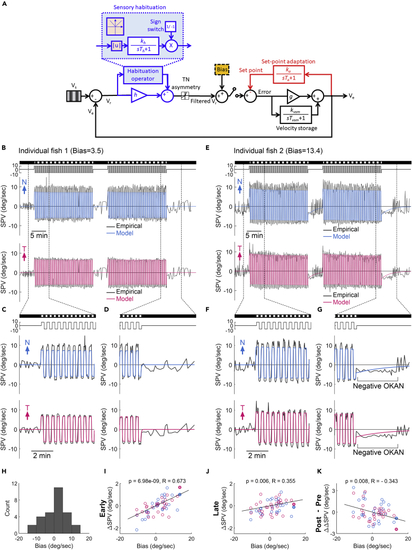Fig. 5
- ID
- ZDB-FIG-230403-14
- Publication
- Lin et al., 2022 - Optokinetic set-point adaptation functions as an internal dynamic calibration mechanism for oculomotor disequilibrium
- Other Figures
- All Figure Page
- Back to All Figure Page
|
An innate bias in the optokinetic system accounts for the asymmetric OKN and the corresponding set-point adaptation under the symmetric stimulus (A) A modified mathematical model to explain the asymmetric optokinetic nystagmus (OKN) gain under symmetric stimulation and the following optokinetic afternystagmus (OKAN). The design is based on the proposed model shown in Figure 3A; however, a constant innate bias (yellow box) is introduced to the optokinetic system. (B–G) The model predicted slow-phase velocity (SPV, colored lines) superimposed on the empirical SPVs of individual subjects (black lines) with symmetric (B–D) and asymmetric (E–G) eye movements. (E) is the same data shown in Figure 4A. Considering the starting direction of alternating stimulation was randomized, we aligned the first stimulus direction as positive instead of left or right. Therefore, the plots show one eye started with a nasalward movement (blue trace) and another eye started with a temporalward movement (red trace). The stimulus image pattern (darkness or gratings) and the stimulus velocity are shown on the top as horizontal bars and lines, respectively. (H) The fish counts of the estimated bias (total fish number = 29). (I–K) The early ΔSPV (I), late ΔSPV (J), and the changes of the eye movements in darkness before and after OKN (post-ΔSPV – pre-ΔSPV, ΔΔSPV) (K) plotted over the estimated bias. Vs, stimulus velocity. Ve, the eye velocity. Vr, the retinal slip velocity. Ve, eye velocity. Th, habituation time constant. kh, habituation gain. |u|, absolute operator. g, oculomotor gain. Tvsm, velocity storage time constant. kvsm, velocity storage gain. Ta, set-point adaptation time constant. ka, set-point adaptation gain. p, p-values; Pearson correlation. R, correlation coefficients; Pearson correlation. |

